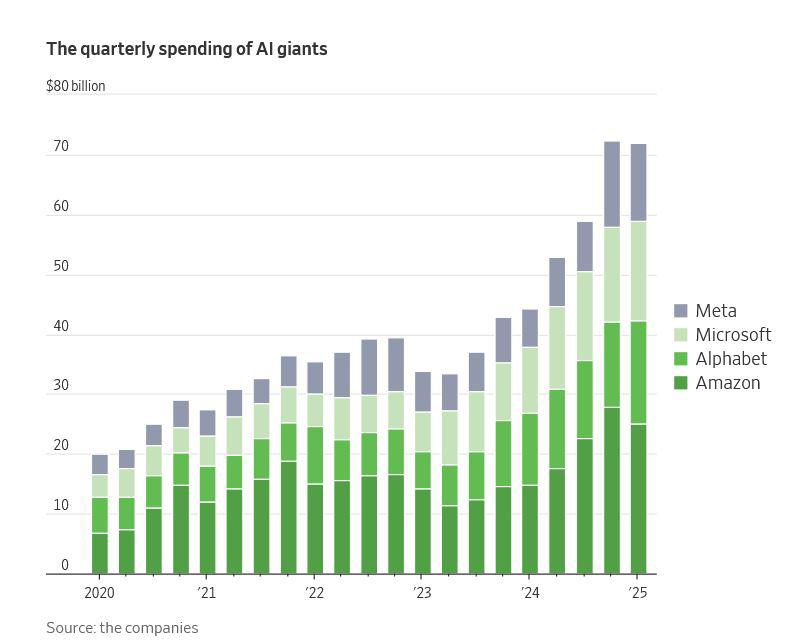Can AI Generate Enough Return?
Investment in AI is rapidly increasing, but is there any return on this sizeable spend? Eidosmedia explores.
If you thought AI investment was bound to slow down soon, think again. Meta recently announced it is seeking $29 billion to build AI data centers. Gartner predicted global spend on Generative AI (Gen AI) to hit $644 billion this year. But does the potential return on investment (ROI) for AI justify the significant — and increasing — spend? With inconclusive results from last year’s reality check on ROI, it’s time to revisit the state of AI investment.

Copyright. The Wall Street Journal
The current state of AI investment
Over the last year, capital expenditure on AI has surged, with tech titans like Google, Meta, Microsoft, and Amazon spending billions of dollars to fund AI innovation. Gartner reports that GenAI, in particular, is “poised for significant growth across all core markets and submarkets in 2025.” Specific areas of spend include:
- Data center and server expansion — The Financial Times reports “spending on data centres will jump from $333bn last year to about $1tn in 2030. By the end of the period, 83 percent of the money will go into AI-related investments.”
- Proprietary software and AI services — According to Gartner, spend on AI software will increase by 93.9% and investment in AI services will increase by 162.9% in 2025.
- Device integration — Gartner predicts that the largest driver of AI spend will be “the integration of AI capabilities into hardware, such as servers, smartphones and PCs, with 80% of GenAI spending going towards hardware.”
- Talent acquisition — In order to get these ambitious AI plans off the ground, enterprises must also start prioritizing investment in visionary AI strategists, innovative engineers, and talented project managers.
The AI investment/adoption paradox
Despite investment in AI increasing across the board, John-David Lovelock, Distinguished VP Analyst at Gartner, points out a prevailing paradox at the heart of AI spend. Though billions of dollars are still being allocated to integrating AI into more areas of business, “Expectations for GenAI's capabilities are declining due to high failure rates in initial proof-of-concept (POC) work and dissatisfaction with current GenAI results.”
McKinsey’s 2025 analysis of the AI landscape also addresses this so-called AI paradox: “Nearly eight in ten companies report using gen AI—yet just as many report no significant bottom-line impact.” McKinsey posits that this gap is due to a steep learning curve and slow adoption. Their research found that despite a global value potential between $11 trillion and $18 trillion, from 2018 to 2022, “AI adoption remained relatively stagnant, with about 50 percent of companies deploying the technology in just one business function.”
The advent of more user-friendly applications like ChatGPT has increased adoption — McKinsey found “more than 78 percent of companies are now using gen AI in at least one business function” in 2025 — but despite increased use, 80% of companies “still report no material contribution to earnings from their gen AI initiatives.” Even more alarming, only 1% of the businesses McKinsey studied considered their AI strategies “mature,” indicating that there’s a lot more high-level work to be done before AI begins bearing more lucrative fruit.
How can AI become more profitable?
Based on these findings, there is significant work left to be done before AI begins delivering on its highly anticipated returns. But fortunately, a path forward seems to be emerging.
McKinsey suggests businesses must start by correcting the imbalance between “horizontal use” (think enterprise chatbots and productivity tools that save time, but only for those who use them) and “vertical use cases” which are built into “specific business functions and processes.” McKinsey suggests vertical use of AI has “seen limited scaling in most companies” but has a “higher potential for direct economic impact.” Furthermore, companies that have shifted to a more vertical approach have often siloed AI to “isolated steps of a business process and operated in a reactive mode when prompted by a human, rather than functioning proactively or autonomously.”
Agentic AI may be the path to profitability
To shift from the AI paradox to the long-promised payout, McKinsey champions “agentic AI” — AI systems that are capable of proactivity and autonomy, in turn offering more streamlined processes, improved efficiency, and increased scalability. McKinsey offers three pieces of advice to help harness the power of agentic AI:
- Increase automation — “By automating complex business workflows, agents unlock the full potential of vertical use cases. Forward-looking companies are already harnessing the power of agents to transform core processes.”
- Reimagine workflows — For AI agents to help instead of hinder, “companies must reinvent the way work gets done—changing task flows, redefining human roles, and building agent-centric processes from the ground up.”
- Establish trust — Though agentic AI will require significant structural and operational changes to succeed, McKinsey believes, “the bigger challenge will not be technical. It will be human: earning trust to drive adoption and establishing the proper governance protocols.”
For now, the returns of AI have not nearly delivered on the immense investment, but the companies betting big on AI aren’t focused on middling gains; they’re positioning themselves for an infrastructural and cultural shift that could very well define the next era of business operations. Only time will tell if the fruit AI bears will surpass the cost of growth, but one thing is clear: AI is here to stay and demands more attention and consideration than ever before.

